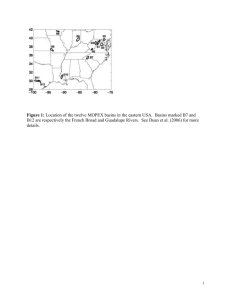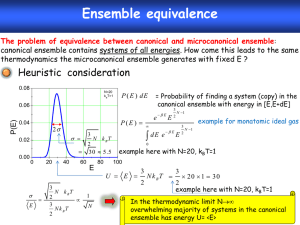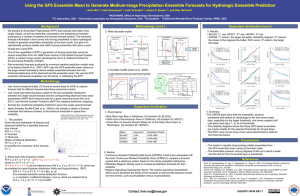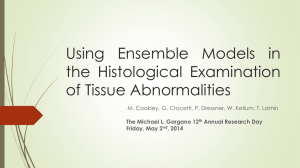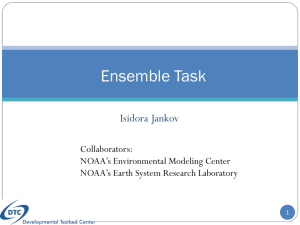2014 Ensemble User`s Workshop Report
advertisement
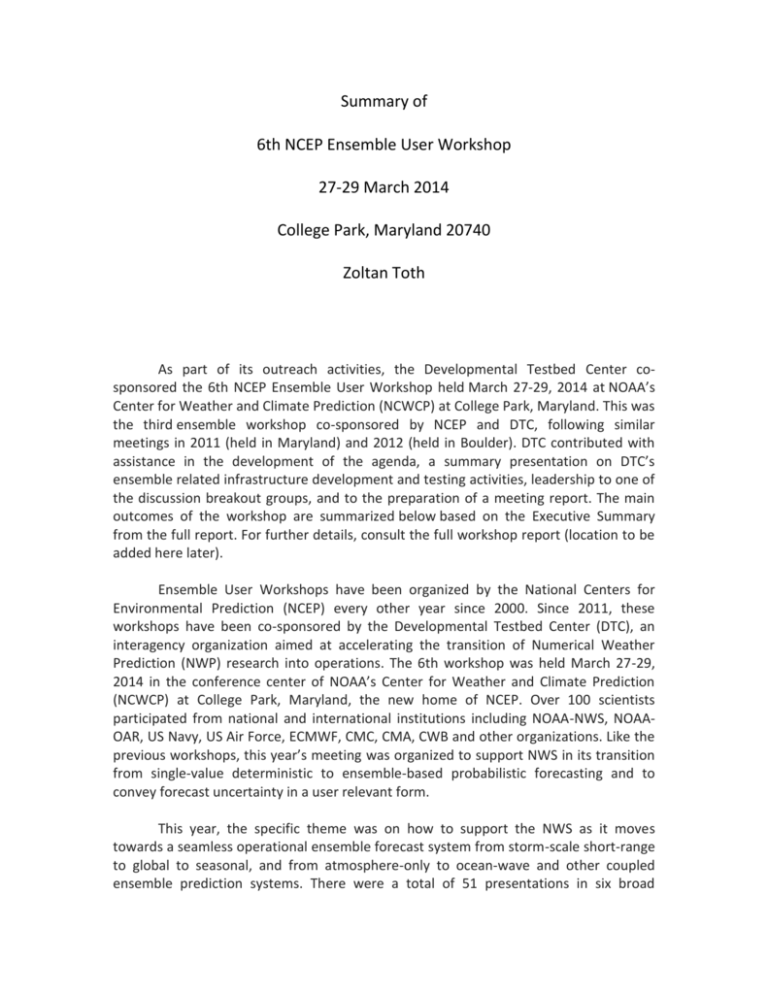
Summary of 6th NCEP Ensemble User Workshop 27-29 March 2014 College Park, Maryland 20740 Zoltan Toth As part of its outreach activities, the Developmental Testbed Center cosponsored the 6th NCEP Ensemble User Workshop held March 27-29, 2014 at NOAA’s Center for Weather and Climate Prediction (NCWCP) at College Park, Maryland. This was the third ensemble workshop co-sponsored by NCEP and DTC, following similar meetings in 2011 (held in Maryland) and 2012 (held in Boulder). DTC contributed with assistance in the development of the agenda, a summary presentation on DTC’s ensemble related infrastructure development and testing activities, leadership to one of the discussion breakout groups, and to the preparation of a meeting report. The main outcomes of the workshop are summarized below based on the Executive Summary from the full report. For further details, consult the full workshop report (location to be added here later). Ensemble User Workshops have been organized by the National Centers for Environmental Prediction (NCEP) every other year since 2000. Since 2011, these workshops have been co-sponsored by the Developmental Testbed Center (DTC), an interagency organization aimed at accelerating the transition of Numerical Weather Prediction (NWP) research into operations. The 6th workshop was held March 27-29, 2014 in the conference center of NOAA’s Center for Weather and Climate Prediction (NCWCP) at College Park, Maryland, the new home of NCEP. Over 100 scientists participated from national and international institutions including NOAA-NWS, NOAAOAR, US Navy, US Air Force, ECMWF, CMC, CMA, CWB and other organizations. Like the previous workshops, this year’s meeting was organized to support NWS in its transition from single-value deterministic to ensemble-based probabilistic forecasting and to convey forecast uncertainty in a user relevant form. This year, the specific theme was on how to support the NWS as it moves towards a seamless operational ensemble forecast system from storm-scale short-range to global to seasonal, and from atmosphere-only to ocean-wave and other coupled ensemble prediction systems. There were a total of 51 presentations in six broad categories listed as follows: (1) Review of current status and future plans of operational ensemble forecast systems, (2) NWS users’ feedback, (3) Ensemble post-processing methods and generation of probabilistic products, (4) Special projects and international development, (5) Products, data and verification, and (6) Community development. In addition to the presentations, a discussion period followed each session. Operational numerical weather and climate guidance are fundamental tools for the government, private and public sectors to improve public safety, quality of life, and socioeconomic decisions. Ensemble forecast systems comprise the cornerstone to generate these products in a sense that they provide both single-value (i.e., best “deterministic”) and probabilistic guidance. NCEP generates operational ensembles on various time scales and spatial domains: The Short-Range Ensemble Forecast System (SREF) for the Continental US (CONUS) and North American Model (NAM) domains out to 84 hours lead time, The Global Ensemble Forecast System (GEFS) for the global domain and for medium and extended ranges (3-14 days lead time), and the CFSv2, which provides monthly-average and seasonal ensemble forecasts over a global domain. NCEP also generates downstream ensembles including the wave and hurricane ensembles (HWRF ensemble). NCEP also collaborates with numerous partners to produce Multi-model Ensembles. The first and most advanced collaboration is with the Canadian Meteorological Center (CMC), to produce the North American Forecast Ensemble System (NAEFS). This system provides skillful and reliable guidance for day 1-16. In collaboration with CMC and the US Navy, another system routinely produced is the NUOPC ensemble. For seasonal forecasting, the CFSv2 is combined on a monthly basis with national centers to generate the National Multi-Model Ensemble (NMME). In addition, NMME is also combined with the EUROSIP to create the International MultiModel Ensemble (IMME). New capabilities are underway that include the extension of the GEFS to 30 days and the creation of a Rapid Refresh ensemble. This trend indicates that ensembles are moving to diverse directions in operations, connecting with new application areas such as Data Assimilation and seasonal forecasting. Given the growing role of ensemble forecasting in weather and climate forecasting, the exchange of the latest information on current and future developments between users and developers of these systems is ever more important. The workshop stimulated lively discussions and offered enlightening insights into emerging trends in ensemble forecasting.




